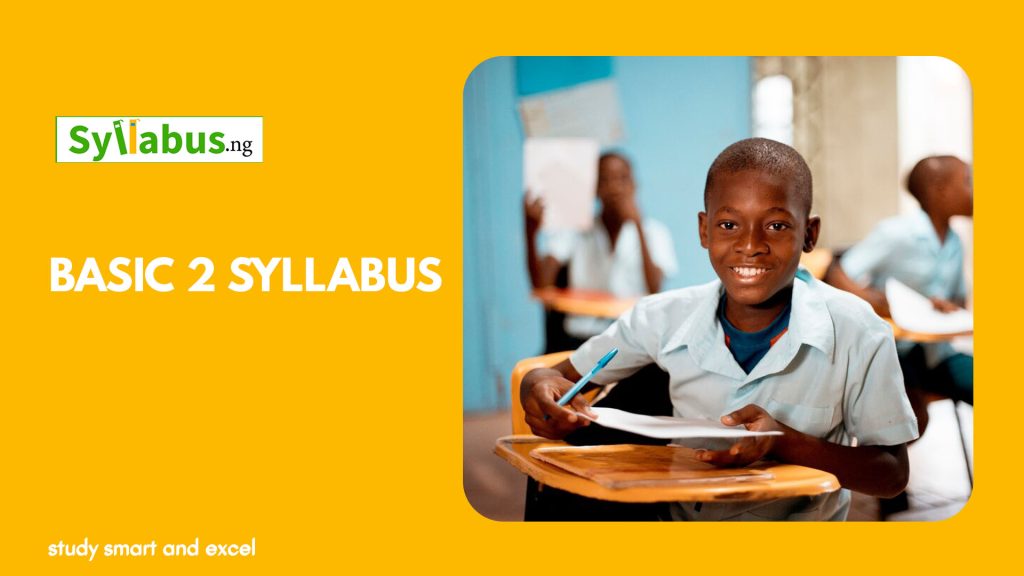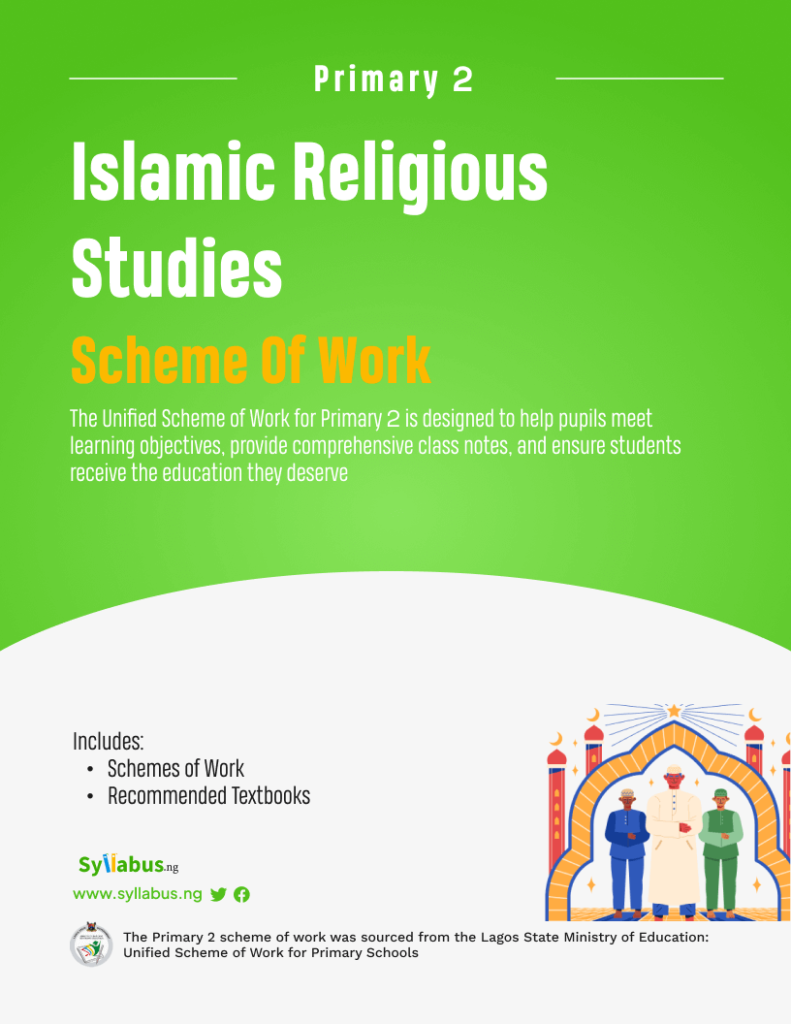Download the Unified Basic 2 Scheme of Work for Islamic Religious Studies, to serve as a guide for educators and primary school teachers

Home » Primary 2 Scheme of Work » Primary 2 Islamic Religious Studies (IRS) Scheme of Work
Islamic Studies for primary school is designed to train the pupils on how to practice their religion properly. The topics for this class are centered on the foundation of islam, and the prerequisite. They will also be taught some simple surahs and their meaning together with how to perform salah.
The topics covered in this class are; Introduction to Arabic vowels; Fatihah, Kasrah, Dummah. Suaratul Lahab, attributes of Allah, names of the prophet; Adam, Nuh, Ibrahim, Ismail, Isa, Muhaammad, Musa.
They will also be taught how to join two and three letter words, Iqamah(Call to prayer), practical demonstration of rak’ah, At-Tashahud, Salatul Al Jama’ah and virtuous conduct.

Know what’s expected of you as an educator
Download the Lagos State Unified Scheme of Work for Primary 2 Islamic Religious Studies (IRS)
| LAGOS STATE GOVERNMENT MINISTRY OF EDUCATIONUNIFIED SCHEMES OF WORK FOR PRIMARY SCHOOLS | ||
| Islamic Religious Studies Scheme of Work for Primary/Basic 2 | ||
| CLASS | Primary/Basic 2 | |
| SUBJECT | Islamic Religious Studies | |
| TERM | First Term | |
| WEEK | TOPICS | Learning Objectives |
| 1 | Readiness test/Revision | By the end of the lesson, the pupils should be able to: i. List some topics treated last session; ii. justify the relevance of those topics; iii. solve all questions related to the last session work done |
| 2 | Introduction of Vowels Fätihah, Kasrah and Dummah | By the end of the lesson, the pupils should be able to: i. recognize the signs of these vowels ii. distinguish between the vowels: Fätihah, Kasrah and Dummah iii. participate in writing and using vowels with some Alphabets |
| 3 | Süratul-Lahab (Q 111) 1-3 | By the end of the lesson, the pupils should be able to: i. recite Süratul-Lahab (Q111)with appropriate tone (1-3) ii. examine the meaning of these verses iii. commit these verses to memory |
| 4 | Süratul-Lahab (Q 111)4-5 | By the end of the lesson, the pupils should be able to: i. recite the remaining verses of Süratul•Lahab with appropriate tone (verse 4-5) ii. examine the meaning or these verses iii. commit the complete Surah to memory |
| 5 | Attributes of Allah (SWT) | By the end of the lesson, the pupils should be able to: i. explain the meaning of following attributes ofAllah : – AlHaadi (The Guide), -Al-Malik (TheRuler). -Al-Hakim (The Judge), -Al-Basir (The All Seeing), -As-Samiu ( The All Hearing) ii. relate these names of Allah as it affects man iii. memorize these names of Allah with their meaning |
| 6 | Learning five names out of the twenty-five names of Allah’s Messagers mentioned in the Qur’än | By the end of the lesson, the pupils should be able to: i. recall the names of these Prophets of Allah: – Idris, -Ibrahim, -Ismail, -Is.haq, -Yusüf(AS) ii. assess the function performed by these Prophets of Allah iii. cite the relevant verse from the Qur’ån |
| 7 | Mid Term Tests/Open Day/Mid Term Break | |
| 8 | Brief history of Prophet Adam (AS) | By the end of the lesson, the pupils should be able to: i. narrate the history of the creation of Prophet Adam ii. examine the test occurred between Prophet Adam and the Angels iii. discuss thc lesson from the life or Prophet Adam |
| 9 | Bricf history of prophet Nüh | By the end or the lesson, the pupils should bc able to: i. narrate the life history of prophct Nilh ii. examine his quality of endurance iii. discuss thc rcsult or his obedicncc and the disobedicncc of his son and the people. |
| 10 | Bricf history of prophet Ibrahim | Bythc cnd of the lesson, pupils through the wholc class discussion should bc able to: i. narate the history of Prophct Ibrahim with reference to his obedience ii.examine his stand against idol worship and his triumph over Idol worshippers iii. discuss the lesson from his persecution and accepting Allah’s will |
| 11 | Brief history of Prophet lsmäil | By the end of the lesson, pupils through the whole class discussion should be able to: i. narrate the history of Prophet Ismail with reference to his father ii. examine his stance against idol worship iii. discuss the lesson from his persecution and accepting Allah’s will |
| 12 | REVISION | |
| 13 | EXAMINATION | |
| CLASS | Primary/Basic 2 | |
| SUBJECT | Islamic Religious Studies | |
| TERM | Second Term | |
| WEEK | TOPICS | Learning Objectives |
| 1 | Readiness test/Revision | |
| 2 | Joining of two letter words | By the end of the lesson, the pupils should be able to: i. identify two letter Arabic words ii. pronounce two letter Arabic words iii. write two letter Arabic words correctly |
| 3 | Süratun-Nasr Verses (Q 110 verses 1 – 2) | By the end of the lesson, the pupils should be able to: i. recite Süratun-Nasr appropriate tone verse (1-2) ii. examine the meaning of the verses commit the verses to memory |
| 4 | Süntun-Nasr (Q 110 verse 3) | By the end of the lesson. the pupils should be able to: i. recite the remaining verse of Süratun-Nasr with appropriate tone (verse 3) ii. examine the meaning of the verse iii. commit the whole Sürah to memory |
| 5 | Iqämah (Ready to pray) | By the end of the lesson. the pupils should be able to: i. explain the meaning of Iqämah ii. call the Iqämah iii. translate each text of the Iqämah |
| 6 | Practical demonstration of a Rak’ah | By the end of the lesson. the pupils should be able to: i. explain the meaning of a Rak’ah ii. show a practical demonsration of a Rak’ah iii. state the steps that makes up a compleu Barah |
| 7 | Mid Term Test Break | |
| 8 | At-Tashähud (The Word of Testimony) | By the end of the lesson, the pupils should be able to: i. explain the meaning and significance of Tashåhud ii. write the text and recite Tashähud iii. state when and where Tashähud can be recited |
| 9 | Brief history of Prophet Yusüf | Bythe end ofthe lesson, the pupils should be able to: i. narrate the history of Prophet Yusüf with reference to his fathers love for him ii. examine the lessons contained in the history of Prophet Yusüf with reference to his dream and relationship with his brothers iii. apply these lessons to daily activities with reference to his stands against temptation |
| 10 | Brief history Of prophet Isä | By the end of the lesson, the pupils should be able to: i. narrate the history of Prophet Isä’s miraculous birth and his mission ii. examine the lessons contained in the history of Prophet Isä as regards his not being the son of Allah and not being crucified iii. apply these lessons to daily activities |
| 11 | History of prophet Muhammad (SAW) from Birth to his Marriage | By the end ofthe lesson, the pupils should be able to: i. narrate the history of Prophet Muhammad from his birth to his childhood ii. examine the lesson contained in his business, associaton with khadijah and his marriage to her iii. apply these lessons to daily activities |
| 12 | Revision | |
| 13 | Examination | |
| CLASS | Primary/Basic 2 | |
| SUBJECT | Islamic Religious Studies | |
| TERM | Third Term | |
| WEEK | TOPICS | Learning Objectives |
| 1 | Readiness test/Revision | |
| 2 | Joining of three letter words | By the end öf the lesson, the pupils should be able to: i. identify three letter Arabic words ii. pronounce three letter Arabic words with different vowel signs iii. write three letter Arabic words |
| 3 | Introduction of Shaddab and Alif-Maddah | By the end of the lesson, pupil should be able to: i. say the meaning of Shaddah and Alif-Maddafi ii. give the reasons why Shaddah is used iii. show some examples of Shaddah and Maddah |
| 4 | Süratul Käfirun(Q 109) 1-3 | By the end of the lesson, the pupils should be able to: i. recite Süratul Käfirun 1-3 ii. transh these verses into English iii. commit the surah to memory |
| 5 | Süratul-Käfirun(Q 109) | By the end of the lesson. the pupils should be able m: i. recite the remaining verses of Süratul Käfirun (verse 4 — 6) ii. translate these verses Into English iii. commit whole Sürah to memory |
| 6 | Salätul-Jam’aah(Congregational Prayer) | By the end of the lesson, the pupils should be able to: i. expIaln the meaning of Salitul-Jamä’ah ii. show a practial demonstration of Salåtul-Jamä’ah procedure iii. state the conditions surrounding Salatul-Jama’ah |
| 7 | Mid Term Tests/Open Day/Mid Terrn Break | |
| 8 | Asmäullähil-Husnä (Beautiful names ofAllah) | By the end of the lesson, the pupils should be able to: i. explain the meaning of the following names of Allah -Allah (God), -Ar-Rahman (The Beneficent), -Ar-Rahim (The Merciful), -Al-Malik (The Sovereign Lord) -Al-Quddus (The Holy) ii. relate these names of Allah as it affects man iii. memorize these names of Allah with their meaning |
| 9 | Asmäullähil-Husnä (Beautiful Names ofAllah) | By the cnd ofthc lesson, the pupils should bc able to: i. explain the meaning of the following names of Allah :- -As-Salam (The Source of Peace), -Al-Mu-min (The Guardian), -Al-Muhaimin (The Protector), -Al- Azecz (The Mighty), -Al-Jabbar ( The Compeller) ii. relate these names of Allah as it affects man iii. memorize these names of Allah with their meaning |
| 10 | Virtuous Conduct in Islam | By the end of the lesson, the pupils should be able to: i. say the meaning of punctuality and cleanliness ii. state the places where punctuality and cleanliness arc needed iii. justify the importance of punctuality and cleanliness |
| 11 | Brief history of Prophet Musä | By the end of the lesson, the pupils should be able to: i. narrate the history of Prophet Musa with reference to his birth and Prophethood ii. exanine his relationship with Fir’awn iii. apply the lessons derived to daily activities |
| 12 | REVISION | |
| 13 | EXAMINATION | |
Workbook

Know what’s expected of you as an educator
Download the Lagos State Unified Scheme of Work for Primary 2 Islamic Religious Studies (IRS)